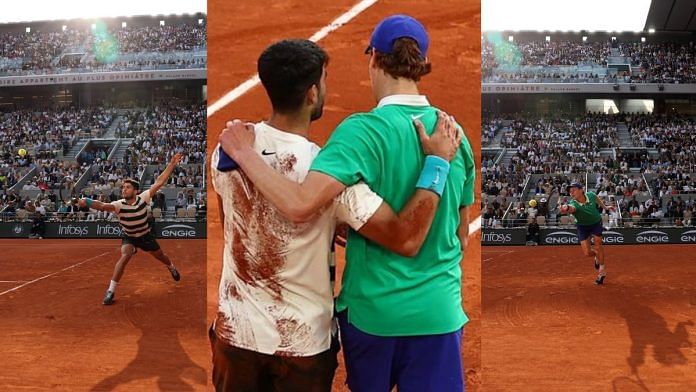But this is not about analysing the incredible five sets that two young tennis players at the peak of their game played against each other in Paris on Sunday night. It is not even about the fact that this may well rank alongside the 2008 Wimbledon final as one of the top 3 grand slam finals ever played. This is about Jannik Sinner and Carlos Alcaraz. It is about exploring why and how two great competitors can raise their game to such stratospheric levels precisely when they need to.
What Alcaraz and Sinner proved on Sunday is that performance is rarely forged in isolation. The ascendancy of the greats, whether it be individuals or teams in elite sports or epoch-defining businesses, is often accelerated by the presence of a formidable rival, a competitor whose skills and ability are matched only by their own.
At its core, a rivalry is a crucible of motivation. When two entities—individuals, teams, or companies—are locked in a contest where neither can afford complacency or even the status quo, the instinct to outdo the other becomes a relentless driver of improvement. It ceases to be merely about winning or losing. In sports, the most celebrated rivalries—Lionel Messi versus Cristiano Ronaldo and Rafael Nadal versus Roger Federer that played out over the past two decades, or the Los Angeles Lakers versus the Boston Celtics that dominated the 1980s, were not just spectacles for fans. They became laboratories of excellence.
The Alcaraz-Sinner final demonstrated what empirical studies confirm—that athletes in direct, high-profile rivalries perform at a higher level than they otherwise would. The Messi-Ronaldo rivalry, examined through the lens of goals and assists, shows that both players’ performances were significantly elevated when their competition was most intense. The presence of a rival who is equally gifted, or even slightly superior, forces each to dig deeper, to innovate, and to perfect their craft. Alcaraz needed to be outhit, outthought, and simply outplayed for over two sets by Sinner last night before raising his own game beyond what his most fervent fans could have expected.
For over a decade, Messi and Ronaldo dominated world football, each pushing the other to ever-greater feats. Their rivalry was not just about individual accolades but about setting a new benchmark for what was possible. When Messi scored a hat-trick, Ronaldo responded with a brace and a match-winning goal. When Ronaldo claimed the Ballon d’Or, Messi redoubled his efforts to reclaim it. The result was a golden era for football, with both players breaking decades-old records.
Nadal-Federer-Djokovic went even further by demonstrating over a two-decade period that a three-way rivalry can be even more potent. When Nadal burst onto the scene as a precociously talented teenager, Federer, standing alone at the top of the tennis world, was forced to improve. Nadal, in turn, on Federer’s retirement, credited him for making the Spaniard a better player. And when Novak Djokovic emerged with his new avatar after an ordinary start to his career, both Nadal and Federer had to move their game a notch higher to compete and win. The result was an incredible 66 Grand Slam titles between them.
In business, the most enduring rivalries, like Coca-Cola versus Pepsi, Nike versus Adidas, and Microsoft versus Oracle, have shaped industries and redefined standards. For over a century, Coke and Pepsi battled for market share, each innovation from one prompting a countermove from the other. The cola wars drove both companies to invest heavily in marketing, product development, and global expansion. The result was a continuous cycle of improvement, with each company raising the bar for the other. The impact of the Nike-Adidas and Microsoft-Oracle rivalries was no less.
Companies like Toyota, Amazon, and General Electric have institutionalised continuous improvement through frameworks born out of the need to stay ahead of rivals, to eliminate waste, and to deliver superior value to customers. Toyota’s Production System, for example, was developed in response to the challenges posed by global competitors. By focusing on quality and efficiency, Toyota not only surpassed its rivals but also set new standards for the entire industry.
Similarly, Amazon’s obsession with speed and customer satisfaction is fuelled by the knowledge that rivals are always just a click away. Such rivalries across industry have shown time and again that the need to outperform a worthy competitor drives innovation, sharpens strategy, and compels companies to continually reinvent themselves, just as it does in elite sport.
Working independently, sports psychologists and researchers in business strategy have come to similar conclusions, identifying four elements that drive high performance through competition:
In each of the cases we looked at, from stadiums to boardrooms, these are the four elements that have anchored greatness.
Rivalries drive greatness
The greatest individuals, teams, and companies do not achieve their status in a vacuum. They are elevated by the presence of a rival who is equally skilled, equally ambitious, and equally determined. This rivalry is not a zero-sum game; it is a symbiotic relationship in which each party pushes the other to new heights.
The stories of these rivalries are not just about competition. They are about the relentless pursuit of excellence, the joy of the contest, and the transformative power of a worthy adversary. Whether in the stadium, the boardroom, or the pages of history, it is the presence of a rival that brings out the best in us all.
And just in case any doubts lingered in people’s minds, last night, over five-and-a-half hours and five sets of scintillating tennis, Carlos Alcaraz and Jannik Sinner provided living proof of their joint drive to greatness.
(Edited by Ratan Priya)








